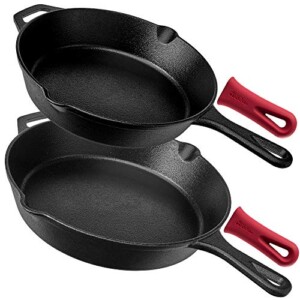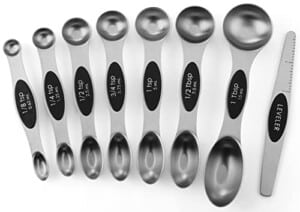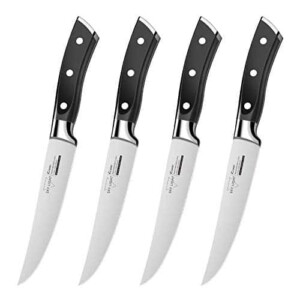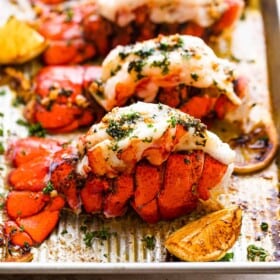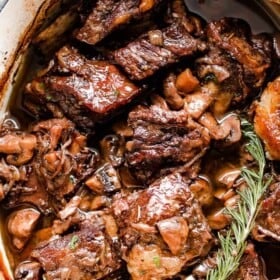Tender and delicious Ribeye Steak cooked to a juicy perfection! Seasoned with fresh herbs, then cooked in a cast-iron skillet and basted with garlic butter, everyone will love this easy steak recipe!
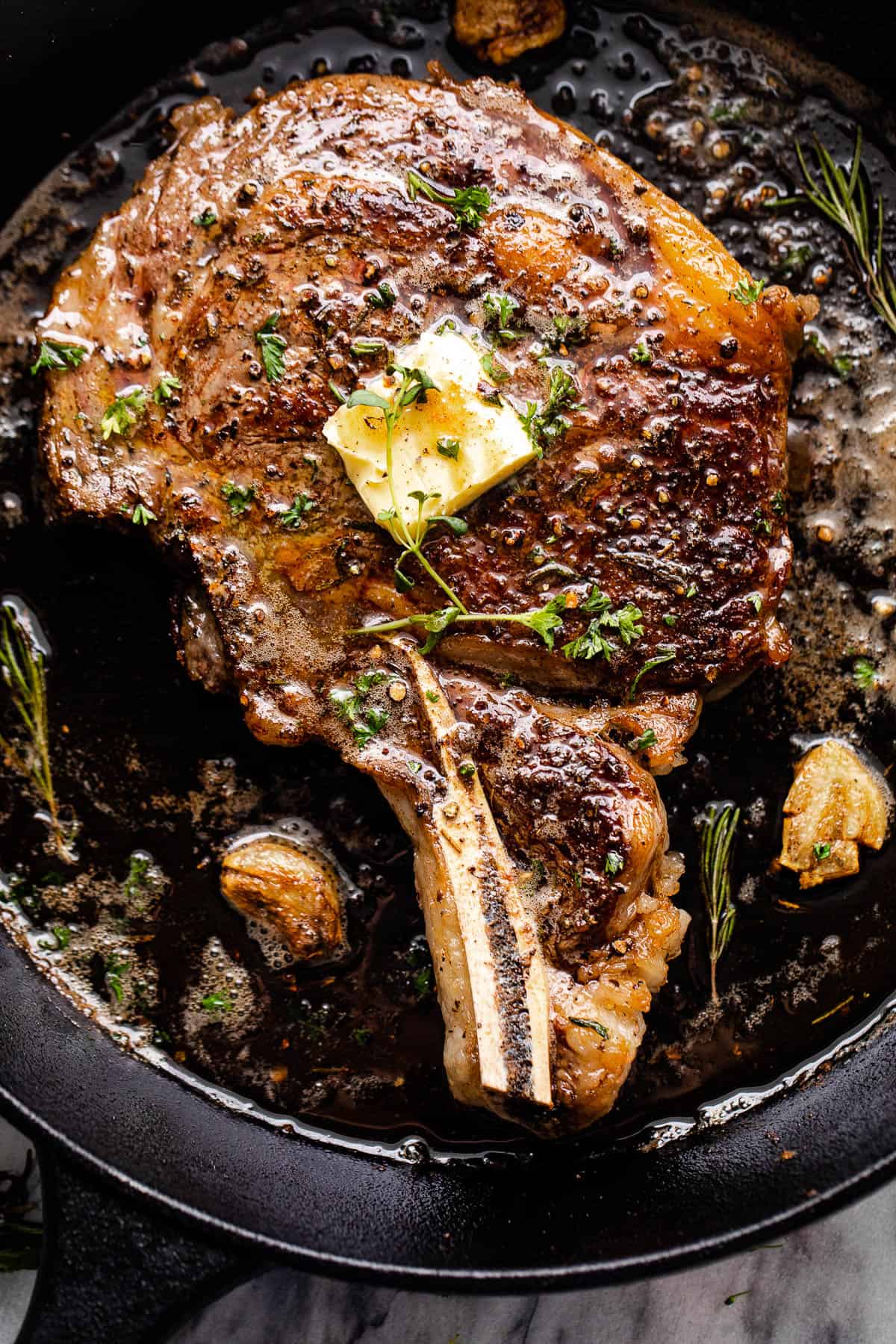
An Easy Rib Eye Steak Recipe
Rib eye steak is just one of those foods that feels… fancy, doesn’t it? But I have some good news! You don’t need to go to a high-end restaurant to enjoy an incredible steak dinner. With quality ingredients and a little technique, you can make the best rib eye steak ever right in your own kitchen.
I’m really excited to share this recipe with you, to be honest. This week is a great time to grab a delicious ribeye (or two… or three! Hello, freezer!) and enjoy a special dinner.
For this particular recipe, I’m keeping it simple and direct. The tender and juicy steak is a perfect ten, dressed only in pan juices, fresh herbs, and crushed garlic cloves.
What is Rib Eye Steak?
Ribeye steak is a boneless rib steak that comes from the rib of the animal. It is one of the “primal cuts” of meat. Ribeye steak is fine and tender with a wholesome, beefy flavor similar to chuck.
You will see the name of this steak spelled two ways: “rib eye” and “ribeye.” Both are correct and refer to the same cut of meat.
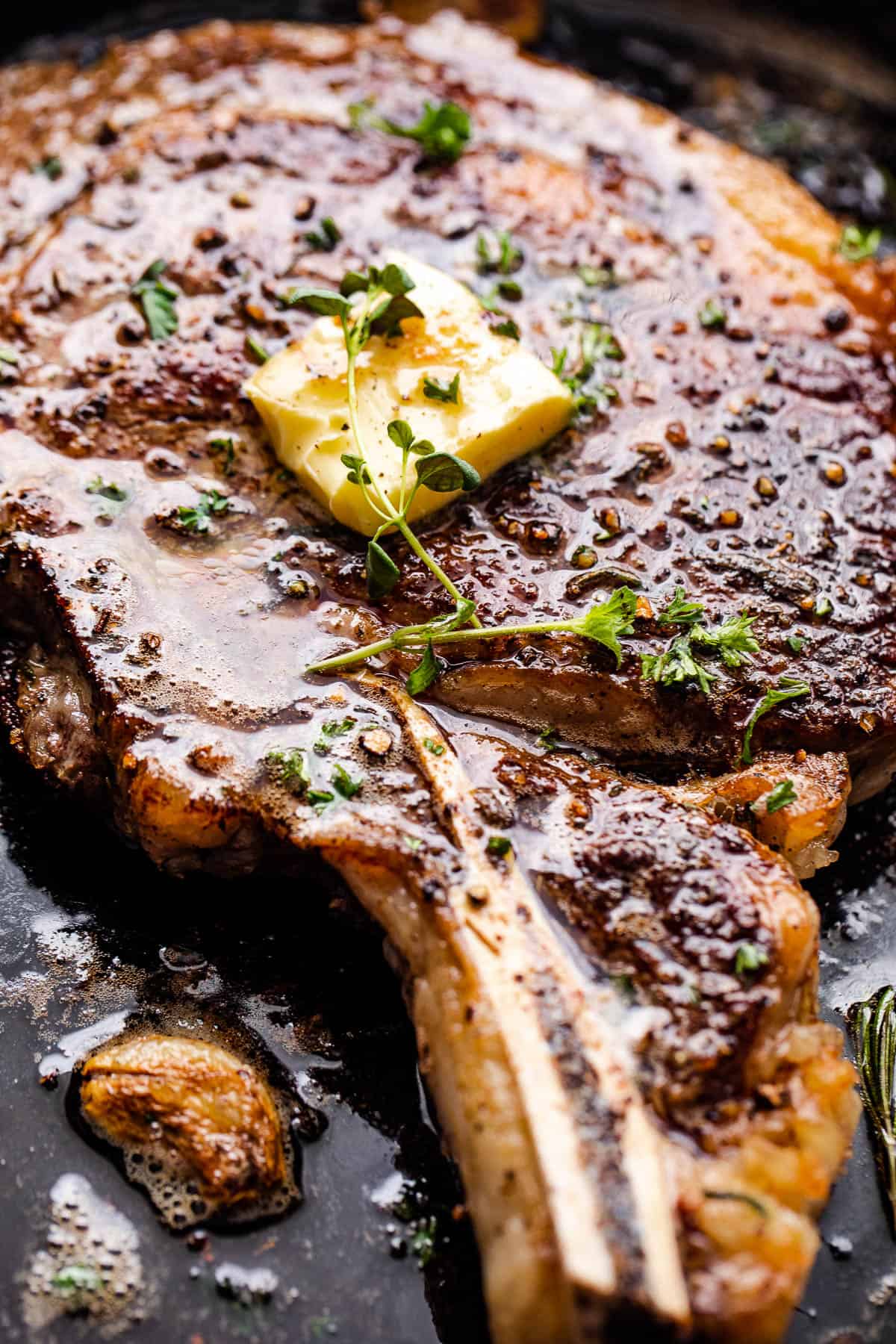
Recipe Ingredients
You don’t really need any fancy ingredients, but I do like to use fresh herbs and the best-quality steak I can find. If you have to use dried herbs, though, no worries! It’ll still be delicious.
- Ribeye: You’ll need a pound or so of bone-in ribeye steak, 1-inch to 1-1/2 inch thick.
- Kosher Salt: To taste
- Freshly Ground Black Pepper: To taste.
- Rosemary: You’ll need to strip the leaves off of a stem or two of fresh rosemary and give it a chop; about 2 teaspoons.
- Fresh Thyme: Again, strip the leaves from the stem and chop them, this time about 1 teaspoon.
- Butter & Oil: You’ll need a couple of tablespoons of unsalted butter and one tablespoon of olive oil, for sauteing.
- Garlic: No need to mince the garlic here, just smash three cloves and peel away the papery outer skin.
- Chopped Fresh Parsley: For garnish.
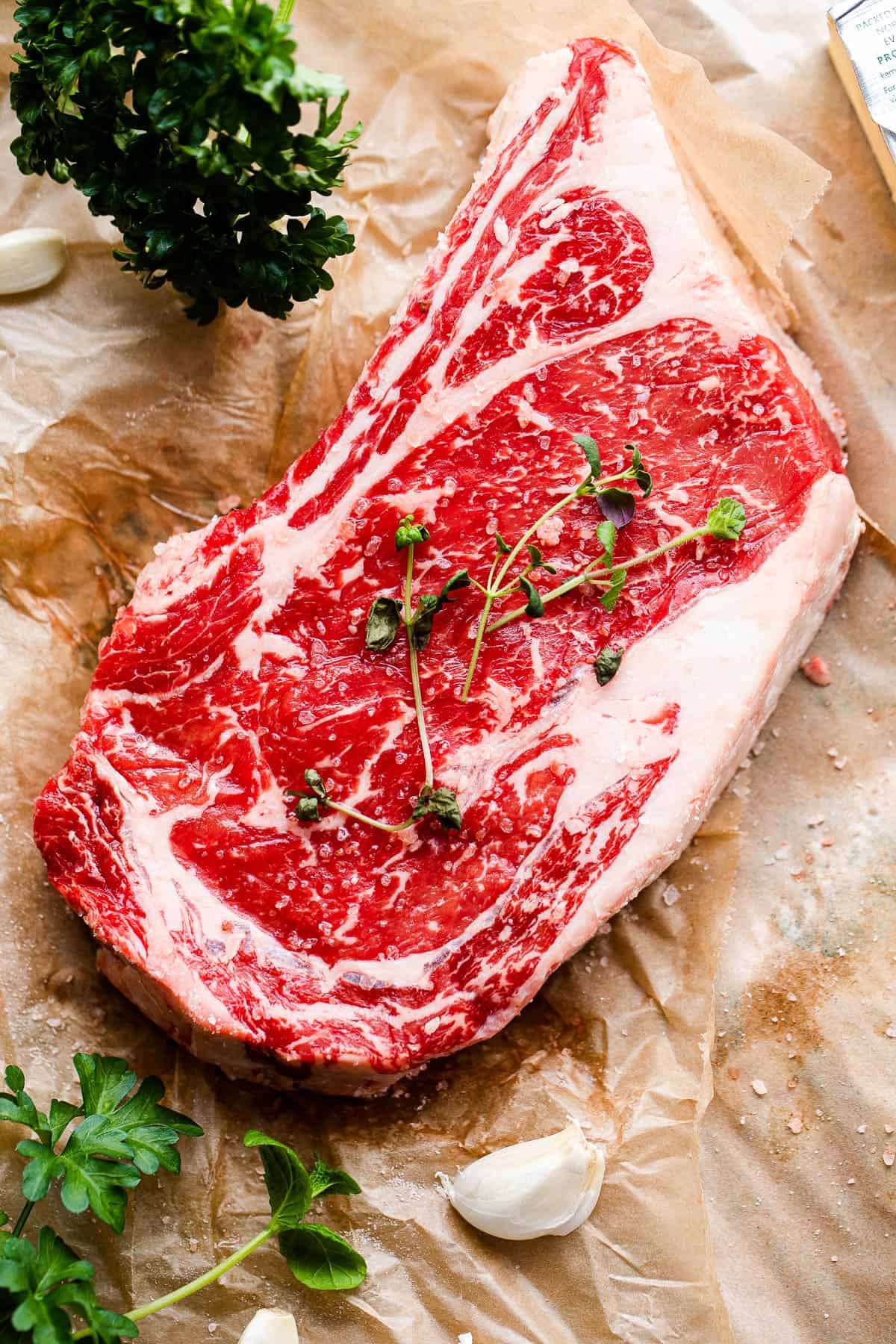
How to Choose the Best Rib Eye Steak
Choosing the best ribeye is kind of an art! But there are a few easy guidelines that even the most inexperienced cook can go by to pick a winner every time.
- Thickness: It’s best to choose a steak between 1 and 1.5 inches. Thinner steaks will cook quickly and be tasty, but it’s harder to tweak the doneness. Similarly, really thick steaks are awesome, but it’s harder to get the doneness right; they’ll almost always be overcooked on the outside or very rare in the center, unless you’re a fairly experienced cook with a few techniques up your sleeve.
- Marbling: Very lean ribeyes may sound great, but they are actually of poorer quality than steaks generously flecked with white fat throughout. That fat, or “marbling,” melts away as the steak cooks and creates a tender, juicy texture.
- Cap and Fat: The cap of the steak is the top section, opposite the thin, boney end. It’s the most tender and flavorful part of the steak, so look for ribeyes that have a generous amount of cap meat. Between the cap portion and the eye portion, which is snuggled against the bone, there should be a small chunk of fat. Look for steaks that don’t have too much fat there; a large, heavy chunk of fat is basically “wasted space,” that won’t be eaten or tenderize the meat.
How to Cook Rib Eye Steak in a Pan
I often broil ribeyes, because it’s a great way to get a sort of grilled effect quickly. But my favorite way to make this is in my trusty 10-inch cast-iron skillet. I renew the seasoning every so often by rubbing the inside with a high heat oil, and then bringing it just to the smoking point on the stovetop.
- Bring Steak to Room Temperature: Take the steak out of the fridge and pat it dry with paper towels. Salt it liberally on both sides. Let it sit on the counter at room temperature for 30 minutes. Room temperature meat will produce juicier, more evenly cooked steaks. Don’t skip this part, please. 🙏😊
- Season Steak: Sprinkle the steak with pepper, rosemary, and thyme; using your fingers, press the herbs down into the meat.
- Cook First Side: In a cast iron skillet (or other heavy-bottomed skillet) over medium heat, heat the olive oil. Add the butter and swirl it around. Place the steak in the skillet, and cook for 5 minutes, or until browned.
- Cook Second Side: Turn the steak over; add the smashed garlic to the skillet, and continue to cook 5 more minutes (for rare steak). Tilt the skillet and spoon the butter drippings over the steak, occasionally.
- Check Doneness & Rest Steak: Check the internal temperature of the steak before removing it from the heat. For a rare steak, the internal temperature should read 120˚F; for medium-rare it should be around 125˚F to 130˚F. Thicker steaks will take longer to cook through. Remove from the heat, and immediately transfer to a cutting board; let it rest for 10 minutes before slicing and serving.
Cooking Times for Steak
Timing the steak for doneness is a flexible thing; depending on the thickness of the steak, the thickness of the pan, and the stove itself, the times will vary. Still, grab an Instant Read Meat Thermometer and follow this guide for help:
- 125˚F to 130˚F internal temperature for RARE
- 135˚F to 140˚F internal temperature for MEDIUM RARE
- 145˚F to 150˚F internal temperature for MEDIUM TO MEDIUM-WELL
- 160˚F internal temperature for WELL DONE
If you absolutely cannot get to an Instant Read Meat Thermometer, this guide should help:
- Rare: 4 to 5 minutes per side
- Medium-Rare: 5 to 6 minutes per side
- Medium: 6 to 7 minutes per side
- Medium-Well: 7 to 8 minutes per side
- Well Done: 8 to 9 minutes per side

Tips for Success
Want more tips on getting the best results with your ribeye? No problem! Here are all my best tricks for delicious steak.
- Get the Pan Hot: It’s important to have the pan nice and hot before you add the steak. That way, it will sear and stay juicy. If the pan isn’t hot enough, the steak will release its juices into the pan instead.
- Instant-Read Thermometer: Any meat thermometer will do, but the instant-read type are my favorite, because you can check the meat very quickly (and even do so multiple times) until it’s just right.
- The Steakhouse Butter Trick: You can add an extra dimension of yummy, succulent flavor to your steak by placing a pat of butter on top while it rests. The butter will melt onto, and almost into, the steak. Yum! 😋
Serving Suggestions
What goes well with this delicious steak? Honestly, just about anything! Here are a few of my favorites.
- Pair with Salad: My Strawberry Avocado Pasta Salad with Balsamic Glaze is such a fresh and flavorful salad that will add a nice pop of sweetness to your date night dinner.
- Serve with a Casserole: You won’t believe how well this Spinach, Feta and Potatoes Au Gratin goes with pan-seared steak. It’s a cheesy, creamy casserole that no one can resist!
- Pair with Stuffed Mushrooms: If you want an ultra tasty side dish to pair with your ribeye steak, these Crab Stuffed Mushrooms are sure to hit the spot.
- Add some popovers: Want to add a fancy side that hardly takes any effort? Try making a simple popover recipe to serve with your dinner.
- Want to go low carb? For a low-carb bready side, try this cloud bread recipe.
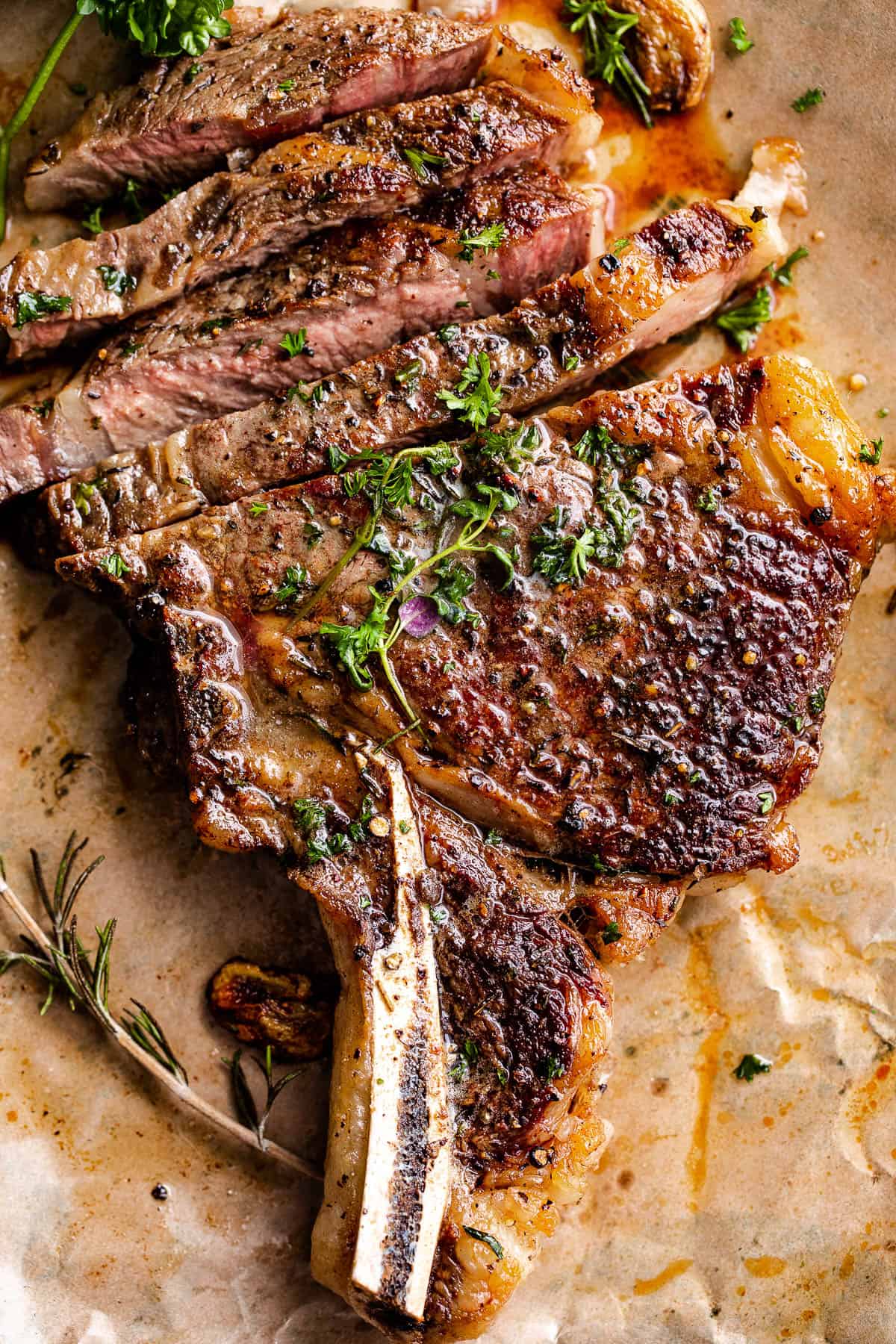
How to Store and Reheat Leftovers
It’s best to prepare and enjoy steak fresh, but if you must save leftovers, here are some helpful tips!
- To Refrigerate: Place leftover steak along with the pan juices into shallow, airtight containers or food storage bags. Keep refrigerated for up to 3 days.
- To Freeze: Wrap the strap well in plastic wrap and then a layer of foil. Freeze for up to 2 months.
- To Reheat: First, thaw leftovers overnight in the refrigerator (if frozen). Then, bring the meat to room temperature on the countertop, about 20 minutes. Finally, reheat in a covered skillet over low heat until it reaches the correct internal temperature of 120˚F, or a little above.
ENJOY!
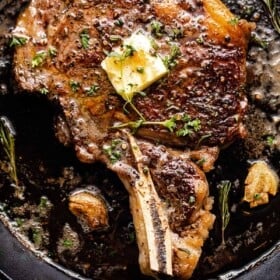
Rib Eye Steak
Ingredients
- 1 pound bone-in rib eye steak, 1 to 1-½ inch thick
- Kosher salt, to taste
- Freshly ground black pepper, to taste
- 2 teaspoons chopped fresh rosemary
- 1 teaspoon fresh thyme leaves
- 2 tablespoons unsalted butter
- 1 tablespoon olive oil
- 3 cloves garlic, smashed
- Chopped fresh parsley for garnish
Instructions
- Take steak out of the fridge; pat it dry with paper towels and salt the steak liberally on both sides. Let sit on the counter (at room temperature) for 30 minutes. Room temperature meat will produce juicier, more evenly cooked steaks.
- Season steak with pepper, rosemary, and thyme; using your fingers, press down the herbs to the meat.
- Set a 10-inch cast iron skillet over medium heat. You can also use a heavy-bottomed skillet.
- Heat up the skillet; then add butter and olive oil.
- Melt the butter and swirl it around to cover the entire bottom of the skillet.
- Add the steak to the skillet and cook for 5 minutes, or until browned on the bottom.
- Turn the steak over; add smashed garlic to the skillet and continue to cook for 5 more minutes for a rare steak, basting the steak with the butter drippings. Tilt the skillet so it’s easier to spoon the butter drippings over the steak.
- Check the internal temperature before removing from heat. For a rare steak, internal temperature should read 120˚F; for medium-rare it should be around 125˚F and 130˚F. Thicker steaks will take longer to cook through.
- Remove from heat and immediately transfer steak to a cutting board; let rest for 8 to 10 minutes before slicing and serving.
- Top with parsley and serve.
Equipment
- Stove
Notes
Nutrition
Nutritional info is an estimate and provided as courtesy. Values may vary according to the ingredients and tools used. Please use your preferred nutritional calculator for more detailed info.


